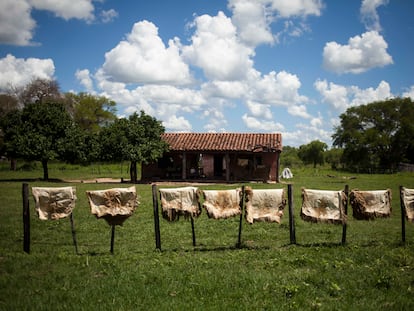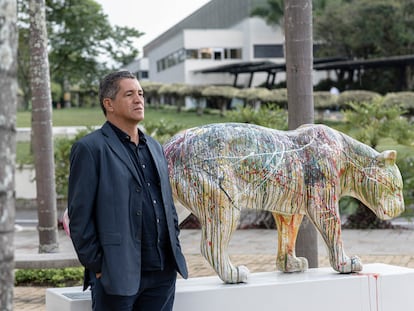Between the forest and death in Paraguay
The murder of an Indigenous man from the Ayoreo tribe has been denounced to the authorities. He had been living in voluntary isolation in Paraguay
The lifeless body of an Indigenous man from the Ayoreo tribe was found at dusk on the last hot day of the year 2023, next to the dry trunk of a white quebracho tree on a dirt road in Paraguay. The corpse — lying on thorny bushes — had the skin on its legs and arms covered in black. Ayoreo men who live in voluntary isolation inside the forest traditionally paint themselves with this color. The body was at the edge of the second-largest continuous forest in South America — the Gran Chaco — shared with Argentina, Brazil and Bolivia.
The Ayoreo are the only Indigenous people in the Americas beyond the Amazon Basin with certain members living without establishing relationships with the society that surrounds them… that is, sans contact with the state, NGOs, Evangelicals, poachers, anthropologists or YouTubers. This is something that’s only possible in the Amazon and the Gran Chaco, due to the enormous forest mass that both regions have maintained since before colonization.
On Sunday, December 31, someone notified the local police station by phone. A photo began to circulate in WhatsApp groups. This is how the image spread to the phones of the Ayoreo and other Indigenous peoples in the area, as well as to the Paraguayans and the Mennonites, whose livestock cooperatives control part of the security and infrastructure of the area, in the absence of the presence of the Paraguayan state. A little later, the photo and the news reached the cities and the Attorney General’s Office.
The legs and arms were covered in black — a tradition that the Ayoreo men observe when they are about to hunt. It’s a forest filled with thorns, pumas and jaguars. The upper-half of the body was totally destroyed.
An analysis of the chest — opened and pierced by bullets — revealed that the body had been there for some time. It was found just over a mile from Lageranza’i, a tiny Paraguayan town in one of the most untouched natural areas of the continent. Far away from the oceans, it lies in the heart of the Ayoreo people’s ancestral territory. They are native to the forests and lagoons along the border between Bolivia and Paraguay.
“As soon as we saw the photo and the bare feet, we knew it was an isolated Ayoreo. Because the isolated ones don’t wear shoes. [Also, we saw the] traditional black paint and the bracelet on his arm,” says Guei Basui Picanerai, one of the eight community leaders who traveled to the site on January 6. It’s about six hours by car from the Mennonite settlement of Philadelphia — the largest in the Paraguayan Chaco — and 14 hours from the capital, Asunción.
The leaders of the four Ayoreo political organizations claim that someone shot him and fled. That’s why they’re asking for an “extensive investigation” from the Attorney General’s Office… although, due to payment issues, this institution barely has any agents. In fact, when the authorities came to remove the body on January 2, they didn’t pick up key evidence, such as the hair that the Ayoreo leaders later found. This has been shown in videos that Basui has been circulating on social media.
“We demand that our complaint be taken into account and we demand to participate in the entire investigation process,” the Ayoreo leaders affirmed in a press release. “All the Ayoreo people are very sad, because [this individual could have] relatives who weren’t contacted, who [may still be] living in the mountains.”
The body appeared near a tajamar — a well where ranchers accumulate rainwater — near one of the dusty roads in the lushest area of the Paraguayan Chaco region. There, one million hectares of Paraguayan land — belonging to the Defensores del Chaco National Park — and another four million hectares of the Kaa Iya National Park in Bolivia provide shelter to the Ayoreo, who still live as their ancestors did before colonization. They are nomads and hunter-gatherers. Their territory’s borders are drawn by the forest.
“From looking at the body, we think that the person tried to cross the road and drink water, but he ran into someone there. We assume that it was a rancher. Maybe he got scared and shot him. It was at the height of the Trébol Ranch,” says Basui by phone, upon returning from his trip to Lagerenza’i.
“We ask that the territory and way of life of our isolated relatives — who decided not to leave their forest, which is their world — be respected, because they feel safer there. In Paraguay, several isolated Ayoreo groups still live in the forest, but it’s being destroyed more and more… their lives are not respected,” added the leaders of this town of about 5,000 tribal members, who live between Paraguay and Bolivia.
Prosecutors have said they will conduct a DNA test that could be ready within two weeks. The body is now in Asunción, according to Ayoreo leaders.
“Our [Justice Ministry] doesn’t have the [awareness that it should] properly intervene in cases that have to do with Indigenous peoples. Here, they’re not given the same treatment, they take their time… there’s no decisive action taken,” Miguel Ángel Alarcón tells EL PAÍS. He’s the coordinator of the Amotocodie Initiative, an NGO dedicated to supporting the preservation of the Ayoreo people, territory and culture.
What does voluntary isolation mean?
The Ayoreo have always been in the heart of the Gran Chaco, living in groups of about 50 people, exercising their right to self-determination, which is recognized by the Inter-American Human Rights System and by the Constitution of Paraguay. There are 120 isolated Indigenous peoples in the Americas, the vast majority on Brazil’s border with Venezuela, Colombia, Peru and Bolivia.
The Ayoreo — protected by their nomadic way of life, the forest, the savanna and sheer luck — survived European expeditions and modern wars well into the 20th century. Only after 1960 did the obsession of the American Evangelical New Tribes Mission — now renamed Ethnos360 — confront them with our reality. The evangelicals forced them away from their lands… sometimes peacefully, other times not.
Another leader who came to investigate the appearance of the body is Porai Picanerai, from the Chaidí community, which means “refuge” in the Ayoreo language. It’s where many of those who were expelled from the community have lived over the last 20 years, after they were pushed out of the forest by missionaries and soldiers.
Porai Picanerai says that the missionaries forced him to leave his forest and his family in 1986. He details to EL PAÍS how the New Tribes Mission forced them to live in a reservation, where many died due to the lack of antibodies. They were vulnerable to the diseases of the surrounding society and they had to dedicate themselves to semi-forced labor.
To this day, Porai and other Ayoreo individuals fight to get the formal rights to their territory. They defend it and travel through the hot air and dry parcels, documenting the illegal land invasions. They expel loggers and cattle ranchers who may — as has happened now — encounter some of their relatives living in isolation and kill them.
The Gran Chaco — a vast region — is one of the places on the planet where deforestation is advancing the fastest. Paraguay was the most deforested country in South America from 1990 to 2015, according to the Food and Agriculture Organization of the United Nations (FAO). Now, it remains in second place, according to the Global Forest Watch (GFW) satellite system.
About 250,000 hectares of forest are destroyed here every year. About 1,400 hectares per day, or seven trees per second, according to the calculation of Guyra Paraguay, a local NGO. Most of this land is cleared to produce meat and leather for export.
The Chaco is so large that, to this day, a few hundred Ayoreo people manage to stay off the roads, avoiding the trucks and the yellow bulldozers that uproot the trees. They know what’s out there: armed cattle ranch guards, drug traffickers, timber smugglers, religious missionaries and corrupt prosecutors. And they don’t like it.
Environmental conservation specialists and anthropologists from the Amotocodie Initiative agree with the Ayoreo: their survival depends on stopping deforestation in the area and guaranteeing that their ancestral territory remains a forest… and, if possible, that it remains theirs.
Sign up for our weekly newsletter to get more English-language news coverage from EL PAÍS USA Edition
Tu suscripción se está usando en otro dispositivo
¿Quieres añadir otro usuario a tu suscripción?
Si continúas leyendo en este dispositivo, no se podrá leer en el otro.
FlechaTu suscripción se está usando en otro dispositivo y solo puedes acceder a EL PAÍS desde un dispositivo a la vez.
Si quieres compartir tu cuenta, cambia tu suscripción a la modalidad Premium, así podrás añadir otro usuario. Cada uno accederá con su propia cuenta de email, lo que os permitirá personalizar vuestra experiencia en EL PAÍS.
¿Tienes una suscripción de empresa? Accede aquí para contratar más cuentas.
En el caso de no saber quién está usando tu cuenta, te recomendamos cambiar tu contraseña aquí.
Si decides continuar compartiendo tu cuenta, este mensaje se mostrará en tu dispositivo y en el de la otra persona que está usando tu cuenta de forma indefinida, afectando a tu experiencia de lectura. Puedes consultar aquí los términos y condiciones de la suscripción digital.










































